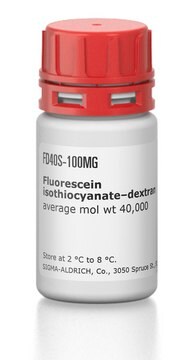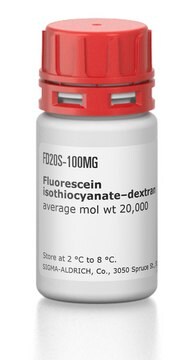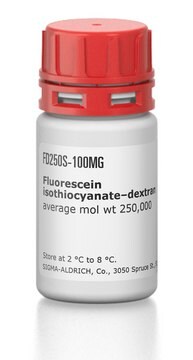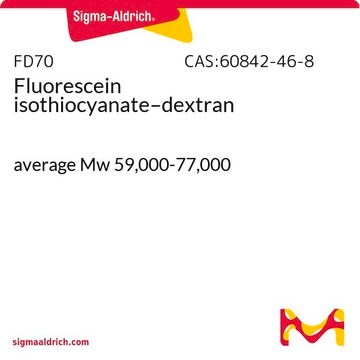46946
Fluorescein isothiocyanate–dextran
average mol wt 150,000, (FITC:Glucose = 1:160)
Synonym(s):
FITC-Dextran 150, FITC–Dextran
Sign Into View Organizational & Contract Pricing
All Photos(1)
About This Item
Recommended Products
form
solid
Quality Level
mol wt
average mol wt 150,000
composition
(FITC:Glucose = 1:160)
extent of labeling
~0.004 mol/mol FITC glucose
solubility
H2O: 25 mg/mL, slightly hazy, very deep yellow-orange
fluorescence
λex 492 nm; λem 518 nm in 0.1 M phosphate pH 8.0
storage temp.
2-8°C
Looking for similar products? Visit Product Comparison Guide
Application
Dextran labeled with fluorescein isothiocyanate for possible use in perfusion studies in animals.
Fluorescein isothiocyanate–dextran (FITC-Dextran 150) is use as a fluorescent probe to study cell permeability. FITC-Dextran 150 is useful to study processes that affect the permeability of the blood brain barrier (BBB) and microvascular structures. FITC-Dextran 150 is used in fluorescence microlymphography.
Other Notes
Commonly utilized as a macromolecular fluorochrome in inflammatory studies
Signal Word
Warning
Hazard Statements
Precautionary Statements
Hazard Classifications
Eye Irrit. 2 - Skin Irrit. 2 - STOT SE 3
Target Organs
Respiratory system
Storage Class Code
11 - Combustible Solids
WGK
WGK 3
Flash Point(F)
Not applicable
Flash Point(C)
Not applicable
Personal Protective Equipment
dust mask type N95 (US), Eyeshields, Gloves
Choose from one of the most recent versions:
Already Own This Product?
Find documentation for the products that you have recently purchased in the Document Library.
Customers Also Viewed
Fátima Z G A Cyrino et al.
Clinical and experimental pharmacology & physiology, 31(3), 159-162 (2004-03-11)
1. The present study was designed to evaluate the effect of micronization on the protective effect of the purified flavonoid fraction (MPFF) on increases in macromolecular permeability induced by ischaemia-reperfusion in the hamster cheek pouch microcirculation. 2. Male hamsters (Mesocricetus
D M Gawlowski et al.
Microvascular research, 37(1), 1-15 (1989-01-01)
Fluorescein-labeled dextran MW 150K (FITC-Dx 150) is commonly utilized as a macromolecular fluorochrome in inflammatory studies. We examined the influence of FITC-Dx 150 on leukocyte activity as assessed by adherence to cheek pouch microvessels. Transcapillary exchange was evaluated as fluorochrome
A Bollinger et al.
Lymphology, 40(2), 52-62 (2007-09-15)
Fluorescence microlymphography (FML) is an almost atraumatic technique used to visualize the superficial skin network of initial lymphatics through the intact skin of man. Visualization was performed with an incident light fluorescence microscope following subepidermal injection of minute amounts of
Takayuki Ishii et al.
Brain research, 1321, 164-168 (2010-01-26)
Ischemia-reperfusion injury is induced by recovery of blood flow after ischemia. This phenomenon is a main cause of ischemic brain injury. The integrity of the blood-brain barrier (BBB) fails after cerebral ischemia and reperfusion. Further elucidation of this phenomenon promotes
Haruo Aramoto et al.
American journal of physiology. Heart and circulatory physiology, 287(4), H1590-H1598 (2004-05-25)
Vascular endothelial growth factor (VEGF) induces mild vasodilation and strong increases in microvascular permeability. Using intravital microscopy and digital integrated optical intensity image analysis, we tested, in the hamster cheek pouch microcirculation, the hypothesis that differential signaling pathways in arterioles
Our team of scientists has experience in all areas of research including Life Science, Material Science, Chemical Synthesis, Chromatography, Analytical and many others.
Contact Technical Service











